From the March 2021 issue of Apollo. Preview and subscribe here.
Somewhere in a cave in the north of Spain there is a prehistoric painting that appears to move. This uncanny phenomenon was described by Francis Bacon in a recorded conversation with his friend, the photographer and environmentalist Peter Beard: Bacon asserts that this image is ‘the most marvellous shorthand of movement that’s ever been made’. The Futurists tried to better it, Bacon says, and so did Duchamp, but no modern artist has surpassed the cave painter’s ability.
Bacon didn’t tell his friend where exactly these pictures are – ‘not Altamira, I can’t remember which of the caves’ – and the images themselves are partial or indistinct, ‘for example, a group of figures and with arrows, one doesn’t know whether they’re going shooting at animals or at another tribe of people coming towards them which aren’t represented’. In fact it is difficult to identify what, precisely, Bacon was talking about – perhaps it is the vagueness of his description which makes it so evocative. It’s possible that he was thinking of the Levantine cave art of eastern Spain, whose hundreds of caves, decorated over thousands of years, are distinctive for their representation of human figures, sometimes in large groups, often depicted in animation – hunting, fighting, and even, at El Cogul, dancing.
When I think of cave art, I rarely think of the human image. Handprints, maybe. But the most famous European works are the horses, bison, and big cats of Lascaux and Altamira. The Levantine figures are unusual not only for their mobility but also because of the way they merge the human with the non-human world. There are hunters and a beekeeper. There are images of encounters between humans and goats, spiders, boar, and deer. The animals, too, are often painted in motion. It is thought that the paint was applied using feathers – parts of a bird’s body, moved skilfully, to depict moving bodies.
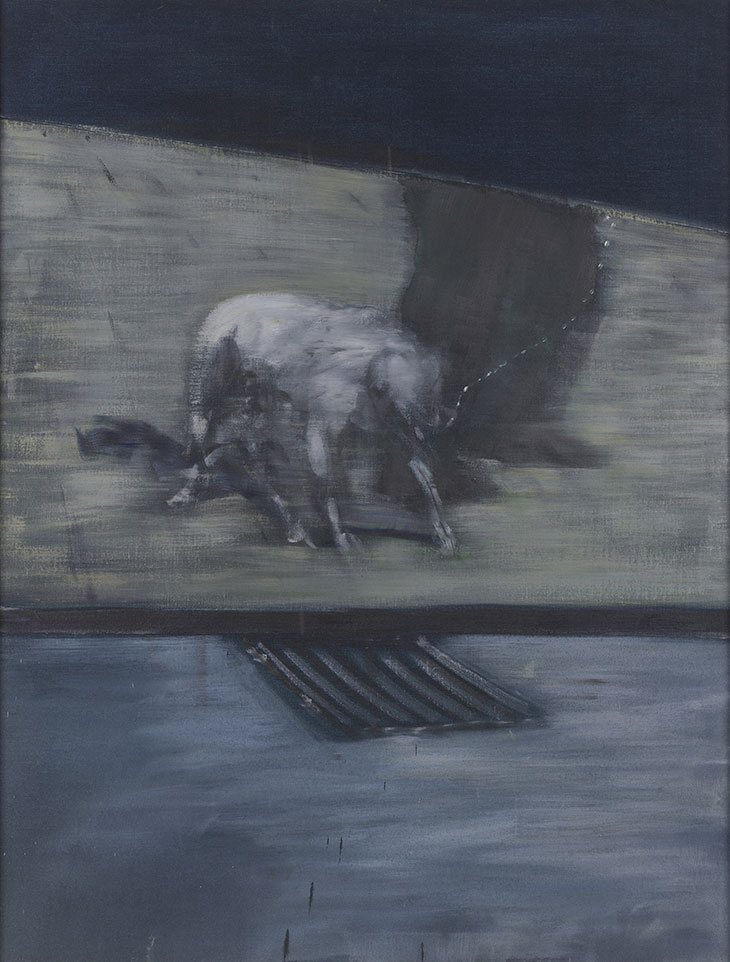
Man with Dog (1953), Francis Bacon. Collection Albright-Knox Art Gallery, Buffalo, New York. Photo: Prudence Cuming Associates Ltd; © The Estate of Francis Bacon. All rights reserved, DACS/Artimage 2021
‘Francis Bacon: Man and Beast’, an exhibition due to open at the Royal Academy in January 2022, examines Bacon’s fascination with movement. The paintings that will be shown are action shots. There are images of distorted meat and contorting flesh. There are screaming jaws and convulsing beasts with two backs: it is rarely possible to distinguish between a painting of torture and of sex. Perhaps there was little in the distinction for Bacon, who was compelled by the sexuality of violence and excited by the violence of sex – he was involved in a long-term sadomasochistic relationship with Peter Lacy, a former RAF pilot. That relationship, one way or another, is visible in several of the images due to go on show at the RA. Bacon was famously enigmatic about the meanings or origins of his pictures, but he is often quoted as describing the effect of a successful painting as an experience of force or violence – ‘to return the onlooker to life more violently’ – the painting’s power as an aggressive physical movement. One could say that this is an odd way to think about pictures, given that painting is, in some respect, antithetical to motion. To paint is to produce stills out of a moving world. Why, then, was this artist fascinated with violent movement, and what did it have to do with animal nature?
For Bacon, the way a man moved was the cruel proof of his bestiality: ‘animal movement and human movement are continually linked in my imagery of human movement’. That link is clearly and painfully articulated in two works that will be shown at the RA, both drawing on Bacon’s knowledge of Eadweard Muybridge’s frame-by-frame studies of animals and humans in motion. In the early 1950s Bacon used Muybridge as a source for his portraits of dogs. The animals appear lonely, ghostly, blurred, ambling through surreal caged or receded landscapes. One Dog painting of 1952 stands on a red ground, lifted out of what looks like a desert, with a palm tree and small cars far away in the background. His head is lowered aggressively, massive balls blurred between his legs, and his facial features are smeared to confusion. Only the bright red tongue lolls vividly.
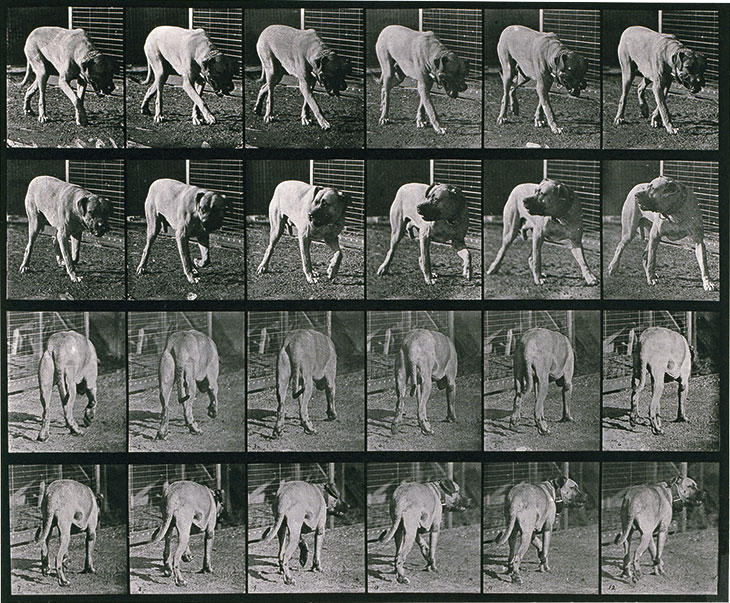
Dog; walking; interrupted, mastiff Dread from Animal Locomotion. An Electro-Photographic Investigation of Consecutive Phases of Animal Movements 1872–1885, Eadweard Muybridge. Royal Academy of Arts, London. Photo: Prudence Cuming Associates Limited; © Royal Academy of Arts, London
Bacon’s dog portraits have a strong affinity with another Muybridge picture he made a decade later. For Muybridge, Infantile paralysis: child walking on hands and feet was an examination of quadrupedal motion, and Bacon’s use of the source image in Paralytic Child Walking on All Fours (from Muybridge) is more or less literal, though the small changes he makes to the figure are telling. The boy’s profile is clearly visible in some of Muybridge’s images, in others he faces the camera, his mouth a little open with the appearance of a smile. Bacon’s boy seems to be facing the viewer but his face has been blanked out with a rosette of paint so that the image is indistinct. Darker patches suggest eye sockets and a muzzle. The boy stands on four legs, leaning forwards, his facial features once again smeared to confusion. There is a hint of a hanging tongue.
There is something very discomforting about the analogy Bacon is painting into being, which responds to an ancient stereotype that aligns unconventional human bodies with those of non-human beasts. But that’s only part of the story. When I look at the picture, what discomforts me is also my own way of seeing. There is no refuge – for me, as a viewer – in a face-to-face gaze. The human face is unusually expressive among animals; in portraits, naturally enough, faces draw the eye. Bacon’s removal of the boy’s face forces the viewer to look at the body and to see it as the picture’s true subject and the greater part of a human form. Where Muybridge studies movement by taking images, frame by frame, Bacon’s study creates an impression of animal movement, not only through the physical effect of the smudged brushstrokes, but also by painting out what is distinctly human about his subject.
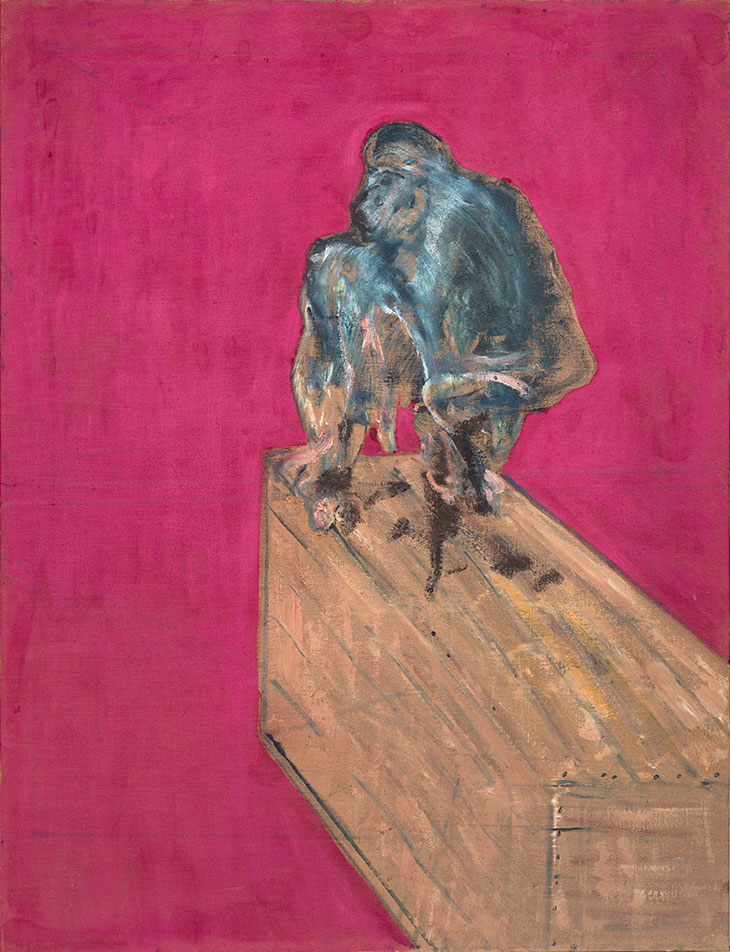
Study for Chimpanzee (1957), Francis Bacon. Peggy Guggenheim Collection, Venice. Photo: David Heald (NYC); © The Estate of Francis Bacon. All rights reserved, DACS 2021
Where Paralytic Child Walking on All Fours asserts an affinity across species, several of Bacon’s most celebrated works contain those affinities in a single frame. Studies of chimpanzees and baboons, pointed teeth bared in gruesome screams, are present in the faces of his screaming human or humanoid heads – the Heads painted from the late 1940s omit parts of the human face to reveal the frayed meat and joints of an animal form. Jaws, canines, bones, tendons. These are hybrid creatures – neither fully human nor animal of any species. They recall Bacon’s hero or nemesis, Picasso, who was differently fascinated with painting animals. Picasso’s large canvas Woman with a Dog (1953) portrays his former lover locked in a violent, sexualised embrace with a creature with bared claws and sharp teeth. The image is a depiction of frantic movement, arrested. The dog’s open jaws are caught in that painful howl that Bacon gave to popes and chimpanzees and made his own.
The comparison between Bacon’s animal paintings and those of Picasso exposes the omissions from Bacon’s corpus. Picasso created a sculpture of a magnificent, milky nanny goat as well as a painting of a snarling dog. He drew Minotaurs and nightmarish animals but also doves and garlands of flowers. Beside Picasso’s version of the natural world, we see how Bacon did not know how to see, or did not care to show, that birth is equally as natural as death, that nurturing insists as well as violence, that there is chlorophyll as well as blood in the universe, that sadism doesn’t always attend sexiness. In this, Bacon’s paintings are not only the product of a rare sensibility, but also the products of a wider narrative of science and the natural world – they are the ‘nature, red in tooth and claw’ articulation of the world view of a particular tribe of white male Europeans in the 19th and 20th centuries. In some ways, these paintings seem quite naive now – a touch adolescent: their view of what it is to be an animal feels stiffly traditional in the 21st century, as scientists and ecologists acquire insights about the vitality of interdependence and the critical role that symbiosis has played in the story of life. Since Bacon’s death in 1992 it has become increasingly apparent that the interpretation of ‘survival of the fittest’, wherein the most fit is always the most aggressive, has not only been a damaging credo for modern humans, it is at best a partial truth, at worst incorrect.
But Bacon’s animals have other stories to tell. He visited the statue of the Sphinx at Giza in 1951, and returned repeatedly to its half-human, half-lion image in paintings over the following decades. In 1979, working on a new sphinx painting, he found that the creature was assuming the features of his friend, Muriel Belcher, who had recently died, though its thick neck and masculine form also had a suggestion of masculinity, as does his Oedipus and the Sphinx after Ingres, painted four years later. Bacon’s sphinxes were intersex as well as interspecies. There is an anecdote, related in Mark Stevens and Annalyn Swan’s new biography of Bacon, about the period of Belcher’s illness. Bacon regularly visited her in hospital, and Belcher consistently greeted him as her daughter. Eventually, a woman in a neighbouring bed on the ward asked Bacon whether he was, against appearance, a woman. ‘Sometimes,’ he replied.
Muriel-Sphinx’s forearms are welded to narrow rigid blocks, much as the forepaws of the Sphinx at Giza rise out of a megalithic foundation. The blocks in Bacon’s painting are lengthened so that the straightened arms appear to be painfully stuck or strapped down. It is striking, in fact, how many of his human-animal paintings include technological or mechanical apparatus, and that often these machines are not merely architecture, ground or background, but continuous with the body. They are images of an inhumane mechanised system in which the living animal is merely an embedded component. Within this system, no creature’s movement can be determined by joints and muscles, much less by free will, but only by the pre-set functions of the machinery. Sometimes these machines are overtly torturous – Second Version of Triptych, 1944, painted in 1988 but explicitly situated in the past, shows wormlike biomorphic forms, pink and naked with exposed ribs and grinning teeth, screaming on tables and a pointed tripod stand. The reference to 1944 is to Bacon’s initial triptych, a sister piece, but seeing that date and looking at that painting, it is hard not to think of the instrumentalised torture and industrialised slaughter of the Holocaust and the final months of the Second World War. Again, though, the images are too enigmatic for a straight interpretation. Perhaps Bacon’s hybrid forms – intersex, interspecies, both body and machine – look forward. They make sense, in the Anthropocene, as rigid distinctions between race, gender, or species, and even between life and non-life, are coming under pressure. In this world, the mobile animal body is not simply threatened by working machinery, but involved in a much more complex entanglement with mechanical apparatus. ‘A Cyborg Manifesto’ by the ecological theorist Donna Haraway states the case clearly: ‘By the late twentieth century, our time, a mythic time, we are all chimeras, theorized and fabricated hybrids of machine and organism; in short, we are cyborgs.’
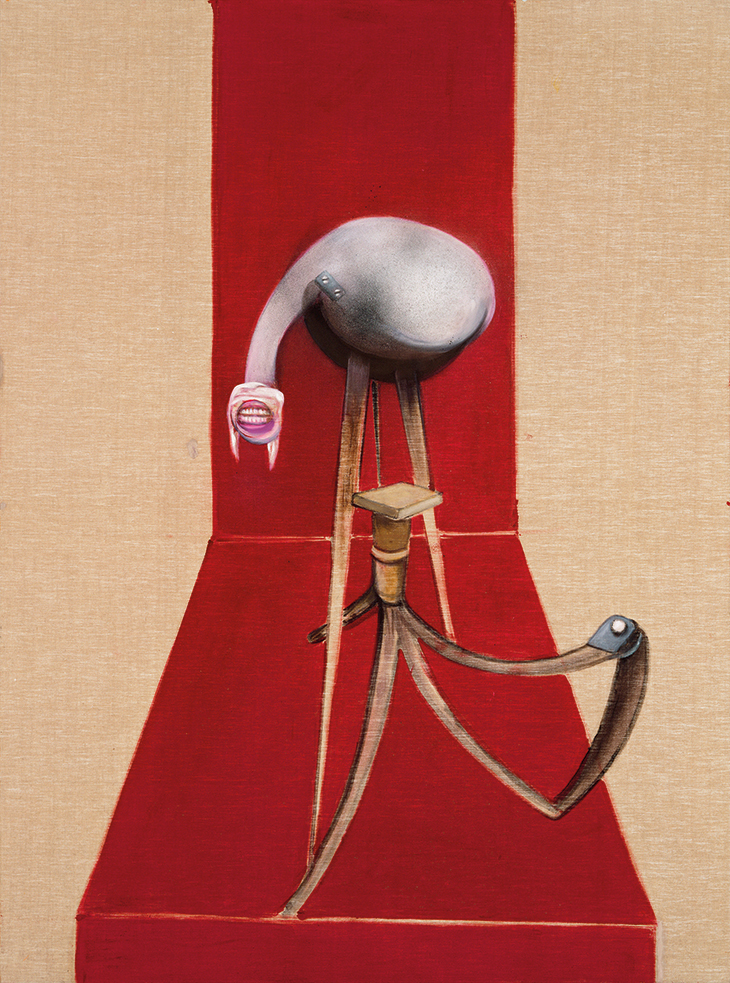
Second Version of Triptych 1944 (central panel) (1988), Francis Bacon. Tate collection. Photo: Prudence Cuming Associates Ltd; © The Estate of Francis Bacon. All rights reserved, DACS/Artimage 2021
If Bacon wanted his pictures to move, he could of course have made films. One of the last works to go on show at the Serpentine Galleries early in 2020, before London was shut down by a microscopic virus, was Patrick Staff’s On Venus. Inside the darkened gallery space Staff installed the corroded apparatus of a broken system. Disconnected pipes leaked acids into steel barrels, a dissociative incantatory soundtrack gave a sense of going back to something ancient. Staff made etchings relating to a confabulated newspaper story that imprisoned child-murderer Ian Huntley had requested medication and surgery so that he could transition to become a woman. There was also a video work presenting found footage of animal slaughter. Positioning these works together, the installation exposed alignments between unsanctioned bodies, human and non-human – the toxic myths about non-binary lives; the toxic processes of factory meat and skin farming; the pipework literally leaking toxic liquids. As an encapsulation of the global circulation, repression, and mass slaughter of living bodies, it’s a marvellous shorthand of movement on an industrial scale. And it sharply recalls Bacon’s paintings, the video work especially.
On Venus, the titular film, begins with a reel of interactions between humans and animals. At first, the footage of the video is suggestively disturbing – children dip small fishing nets into a bucket of water, lifting out bloated froggy creatures, and then plop their static forms back; animal handlers nudge their charges with sticks and shouts. The violence of these interactions rises and continues to rise – the animals are beaten and broken, harnessed, locked up, pursued – until, eventually, we come into the abattoir. Live cattle are queued in a narrow corridor, there is a quick death, and the carcasses skinned. Bloodied chickens are suspended by the feet, twitching. A snake’s skin is scissored off in a single unzipping movement.
It’s the movements these animals make that recall the brutal sexualised movements of Bacon’s paintings: spasms and convulsions. Bacon’s animal works understand the world to which On Venus bears witness – a world in which human and non-human forms bear the violence of their societies’ confusions about animality and humanity, suffering and sex. Bacon made many images which contained amorphous and ambiguous figures – characteristically, he discovers more than one gender, species, or individual, in a single bodily form. His images of animals look back to the cave paintings of farming and hunting, and they look forward, to the threatened hybrid lives of the Anthropocene.
‘Francis Bacon: Man and Beast’ is at the Royal Academy, London, from 29 January–17 April.
From the March 2021 issue of Apollo. Preview and subscribe here.
Unlimited access from just $16 every 3 months
Subscribe to get unlimited and exclusive access to the top art stories, interviews and exhibition reviews.

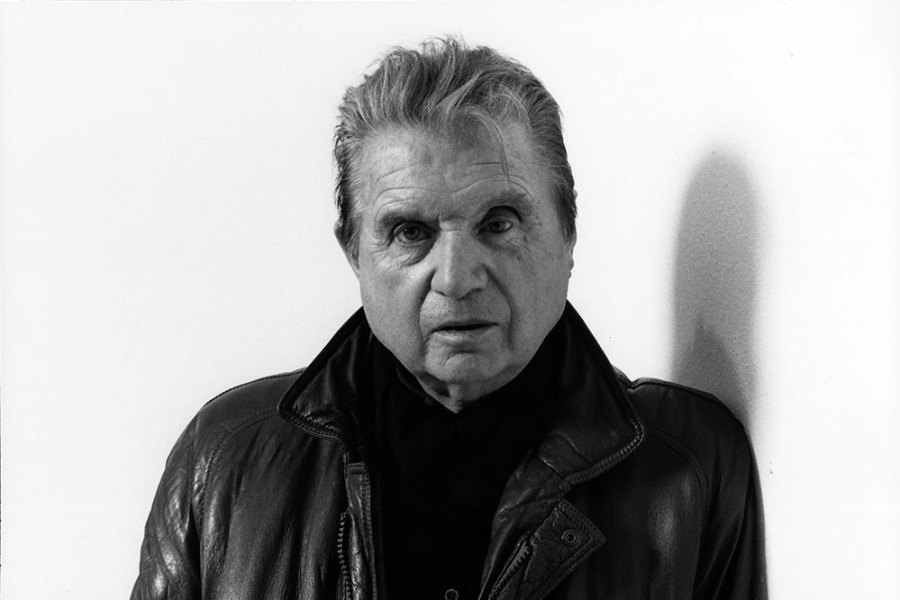
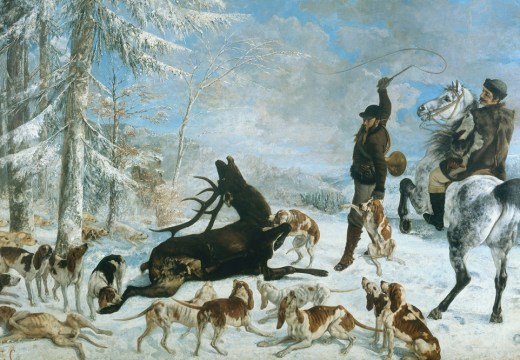
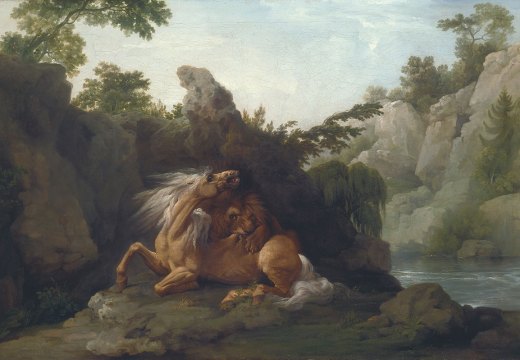
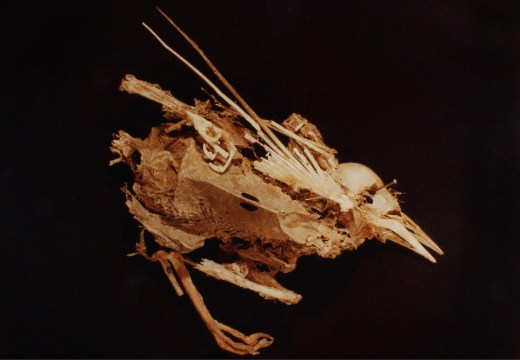









![Masterpiece [Re]discovery 2022. Photo: Ben Fisher Photography, courtesy of Masterpiece London](http://www.apollo-magazine.com/wp-content/uploads/2022/07/MPL2022_4263.jpg)
Has the Fitzwilliam lost the hang of things?